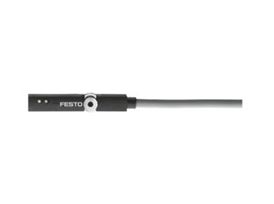FESTO (Festo) Proximity Switch SDBT - MSB - 1L - PU - K - 2 - LE Overview
FESTO (Festo), as a globally renowned supplier of automation technology, is known for its products' high quality, performance, and reliability. The proximity switch SDBT - MSB - 1L - PU - K - 2 - LE is a representative product of Festo. This proximity switch is widely used in the field of industrial automation, capable of accurately detecting the approach of objects and providing reliable signal feedback for automated production processes.
From the perspective of design, SDBT - MSB - 1L - PU - K - 2 - LE features a compact and robust structure, with a housing material that offers excellent protection, allowing it to adapt to various harsh industrial environments. Its dimensions are carefully designed to facilitate installation on different equipment without occupying too much space, providing convenience for the overall layout of the equipment.
Electrical performance-wise, this proximity switch has a stable output signal, accurately identifying the approach and departure of objects. It employs advanced sensing technology, offering high detection accuracy and fast response times, meeting the detection needs of high-speed production lines. Additionally, it has a wide operating voltage range and good compatibility, allowing it to connect with a variety of different control systems.
Features and Advantages of FESTO (Festo) Proximity Switch SDBT - MSB - 1L - PU - K - 2 - LE
Firstly, this proximity switch has extremely high reliability. Festo employs strict quality control standards in the production process, ensuring that every product can work stably and reliably. The electronic components inside SDBT - MSB - 1L - PU - K - 2 - LE are carefully selected and tested, possessing good anti-interference capabilities, allowing normal operation in strong electromagnetic interference environments, significantly reducing malfunctions caused by external interference, and improving the stability of the production process.
Secondly, it has a high protection level. Its housing effectively prevents dust, moisture, and oil污等 from entering the interior, protecting the electronic components from damage. This allows it to be used in harsh industrial environments such as damp, dusty, and oily conditions, extending the product's service life and reducing maintenance costs. For example, on production lines in industries such as food processing and chemicals, this proximity switch can reliably work, providing a guarantee for the production process.
Furthermore, the installation and commissioning of SDBT - MSB - 1L - PU - K - 2 - LE are very convenient. It is equipped with various installation methods, allowing the selection of suitable installation methods based on actual needs. At the same time, its commissioning process is simple and easy to understand. Operators only need to follow the instructions to complete the commissioning work quickly, greatly shortening the equipment installation and commissioning time, and improving production efficiency.
Proximity Switch SDBT-MSB-1L-PU-K-2-LE belongs to the Sensors series under FESTO company, model number SDBT-MSB-1L-PU-K-2-LE. To purchase or inquire about Proximity Switch SDBT-MSB-1L-PU-K-2-LE, you can directly contact 158 0047 0089 (Mr. He).



